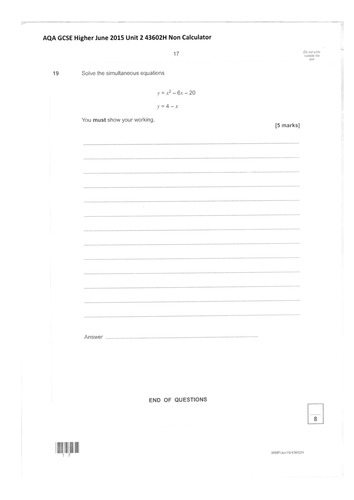











This is about 12 hours of my work. I hope that you can see how it would be used in one or several of your lessons.
The main is 18 Higher Maths GCSE standard exemplar questions on solving simultaneous linear and quadratic equations. I've done the work for you by researching questions from past papers. I've then written solutions and ranked them according to difficulty. I've provided a flow chart for the students to attempt. I've indicated which questions they should all do and which questions are available for additional practice and familiarity if time allows. This illustrates "Maths Mastery" as only the questions needed are presented and it is clear what the progression is or what the "milestones" are in this topic. I think that it's a comprehensive list of the types of question needed at GCSE.
The other mastery (Plenary?) questions are of all the concepts involved. I would present as either questions on the board or as questions on individual cards for them to discuss.
The starter would probably be the linear equations domino cards. They would remind students of how to check that solutions fit and what different methods there are for solving.
The starter I wanted to create but never got around to is presenting a series of curves and lines on cards and getting the students to match up and look for the simultaneous solutions.
The top tips are an idea given by an experienced HOD who told me to make sure that the students know exactly what is needed for the examination.
The Glossary took some time to research and write. I kept adding to it throughout my preparation so I think it's pretty comprehensive.
I used a MEP CIMT resource as a basis of my preparation. Many thanks for them - the URL is given.
I never got around to making the matching PowerPoint presentation but I have given the URL of an example from TES resources which I would use as a basis for planning mine.
The graph drawings on the SMART Notebook I think could provide quite a lot of inspiration for some good starters or even further study - hence I've provided the SMART so that you can edit them.
The main assessment would be the GCSE Sample question. I recognise that I didn't create the question however I have provided the written exemplar solution for you.
I prepared this ready for a GCSE Y10 Interview lesson which I withdrew from a couple of days before the interview. Hence the bulk of the work has been done but it's not complete and needs a little bit more input. The lesson plan suits my style of teaching but it isn't finished. Any questions about this then please make contact.
The main is 18 Higher Maths GCSE standard exemplar questions on solving simultaneous linear and quadratic equations. I've done the work for you by researching questions from past papers. I've then written solutions and ranked them according to difficulty. I've provided a flow chart for the students to attempt. I've indicated which questions they should all do and which questions are available for additional practice and familiarity if time allows. This illustrates "Maths Mastery" as only the questions needed are presented and it is clear what the progression is or what the "milestones" are in this topic. I think that it's a comprehensive list of the types of question needed at GCSE.
The other mastery (Plenary?) questions are of all the concepts involved. I would present as either questions on the board or as questions on individual cards for them to discuss.
The starter would probably be the linear equations domino cards. They would remind students of how to check that solutions fit and what different methods there are for solving.
The starter I wanted to create but never got around to is presenting a series of curves and lines on cards and getting the students to match up and look for the simultaneous solutions.
The top tips are an idea given by an experienced HOD who told me to make sure that the students know exactly what is needed for the examination.
The Glossary took some time to research and write. I kept adding to it throughout my preparation so I think it's pretty comprehensive.
I used a MEP CIMT resource as a basis of my preparation. Many thanks for them - the URL is given.
I never got around to making the matching PowerPoint presentation but I have given the URL of an example from TES resources which I would use as a basis for planning mine.
The graph drawings on the SMART Notebook I think could provide quite a lot of inspiration for some good starters or even further study - hence I've provided the SMART so that you can edit them.
The main assessment would be the GCSE Sample question. I recognise that I didn't create the question however I have provided the written exemplar solution for you.
I prepared this ready for a GCSE Y10 Interview lesson which I withdrew from a couple of days before the interview. Hence the bulk of the work has been done but it's not complete and needs a little bit more input. The lesson plan suits my style of teaching but it isn't finished. Any questions about this then please make contact.
Get this resource as part of a bundle and save up to 71%
A bundle is a package of resources grouped together to teach a particular topic, or a series of lessons, in one place.
Something went wrong, please try again later.
This resource hasn't been reviewed yet
To ensure quality for our reviews, only customers who have purchased this resource can review it
Report this resourceto let us know if it violates our terms and conditions.
Our customer service team will review your report and will be in touch.
£10.00
